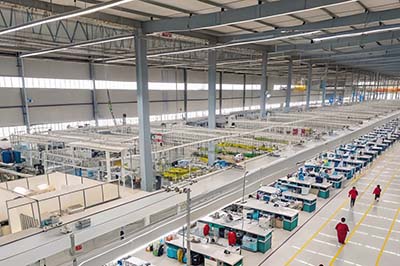Starting a garment factory in Bangladesh can be a lucrative venture, given the country’s established textile industry. However, understanding the associated costs is crucial for effective planning and investment.
The cost to start a garment factory in Bangladesh varies widely, ranging from as little as $5,000 for a small, family-run operation to upwards of $20 million for a large, industrial facility.
Let’s delve into the factors influencing these costs and provide a detailed breakdown.

What are the primary expenses in establishing a garment factory?
Several key expenses contribute to the overall cost of setting up a garment factory.
The primary expenses include factory location, Cost of renting factory space in Dhaka1, machinery and equipment, raw materials, labor, utilities, compliance and licenses, transportation and logistics, marketing and sales, overhead expenses, and contingency funds.
Detailed breakdown of startup costs
| Expense Category | Estimated Cost Range | Description |
|---|---|---|
| Factory Location | $500 – $5,000/month | Costs for renting or purchasing land and constructing or renovating the building. |
| Machinery and Equipment | Varies | Includes sewing machines (Energy efficient sewing machines2), cutting machines, finishing machines, etc. |
| Raw Materials | Varies | Costs for fabrics, threads, buttons, zippers, labels, and interlining. |
| Labor Costs | Varies | Expenses for hiring workers, including salaries and benefits. |
| Utilities | Varies | Costs for electricity, water, and gas. |
| Compliance and Licenses | Varies | Expenses for Bangladesh garment compliance regulations3 and factory registration, trade licenses, fire and safety equipment, etc. |
| Transportation and Logistics | Varies | Costs for importing machinery and equipment, exporting finished products. |
| Marketing and Sales | Varies | Developing a marketing plan, creating a brand, advertising, and promotions. |
| Overhead Expenses | Varies | Office supplies, insurance, accounting, and legal services. |
| Contingency and Miscellaneous | Varies | Unforeseen expenses and miscellaneous costs. |
Note: The above costs are approximate and can vary based on the scale and location of the factory.
How does factory size impact the initial investment?
The scale of your operation significantly influences the startup costs.
A small, family-run garment factory can be established for as little as $5,000, while a large, industrial facility may require an investment upwards of $20 million.

Factors affecting costs based on factory size
-
Small-Scale Operations:
- Lower Initial Investment: Minimal machinery and equipment.
- Limited Production Capacity: Suitable for niche markets or custom orders.
- Flexibility: Easier to adapt to market changes.
-
Large-Scale Operations:
- Higher Initial Investment: Advanced machinery and larger facilities.
- High Production Capacity: Capable of handling large orders.
- Economies of Scale: Potential for lower per-unit costs.
What are the legal requirements and associated costs?
Compliance with local regulations is essential when setting up a garment factory in Bangladesh.
Key legal requirements include factory registration, obtaining trade licenses, and ensuring adherence to safety and environmental standards (Feasibility study garment factory in Bangladesh4).
Breakdown of legal compliance costs
| Legal Requirement | Description |
|---|---|
| Factory Registration | Legal requirement to begin production; includes application fees and documentation. |
| Trade License | Mandatory for conducting commercial activities; involves application fees and renewals. |
| Fire and Safety Compliance | Installation of necessary equipment and adherence to safety protocols. |
| Environmental Clearance | Ensuring factory operations meet environmental regulations. |
Note: Costs for compliance can vary based on factory size and specific requirements.
How do location and infrastructure affect costs?
Choosing the right location is crucial for operational efficiency and cost management.
Factors such as proximity to suppliers, Bulk purchase discounts for textile raw materials5, and markets, infrastructure quality, and labor availability play a significant role in determining costs.

Considerations for selecting a factory location
- Proximity to Suppliers: Reduces transportation costs for raw materials.
- Access to Markets: Facilitates distribution and reduces delivery times.
- Infrastructure: Availability of reliable utilities and transportation networks.
- Labor Availability: Access to skilled and unskilled labor pools.
What are the ongoing operational costs?
Beyond the initial setup, several recurring expenses are essential for the factory’s operation.
Ongoing operational costs include raw material procurement, labor wages, utility bills, maintenance, and marketing expenses.
Key operational expenses
- Raw Materials: Continuous supply of fabrics, threads, and accessories.
- Labor: Regular payment of wages and benefits to employees.
- Utilities: Monthly bills for electricity, water, and gas.
- Maintenance: Upkeep of machinery and facilities to ensure smooth operations.
- Marketing: Ongoing efforts to promote products and secure orders.
How can one optimize costs when starting a garment factory?
Effective cost management strategies can lead to significant savings and improved profitability.
Strategies include conducting thorough market research, negotiating with suppliers, investing in energy-efficient machinery, and implementing efficient production processes.
Tips for cost optimization
- Market Research: Understand demand trends to avoid overproduction.
- Supplier Negotiation: Build relationships to secure bulk purchase discounts.
- Energy Efficiency: Invest in machinery that consumes less power.
- Process Optimization: Streamline operations to reduce waste and increase productivity.
Conclusion
Starting a garment factory in Bangladesh involves a range of costs influenced by factors such as factory size, location, and compliance requirements. A small-scale operation might require an investment of around $5,000, while larger facilities could need upwards of $20 million. Careful planning and strategic decision-making are essential to ensure a successful venture in the competitive garment industry.
-
Discover average rental expenses and possible fluctuations in major industrial zones. ↩
-
Identify modern machinery that reduces operational costs through lower power consumption. ↩
-
Learn about official rules and safety standards required to operate a textile factory in Bangladesh. ↩
-
Explore comprehensive research on financial planning and profit projections for new ventures. ↩
-
Understand how to negotiate better deals with suppliers for large orders of fabrics and accessories. ↩













